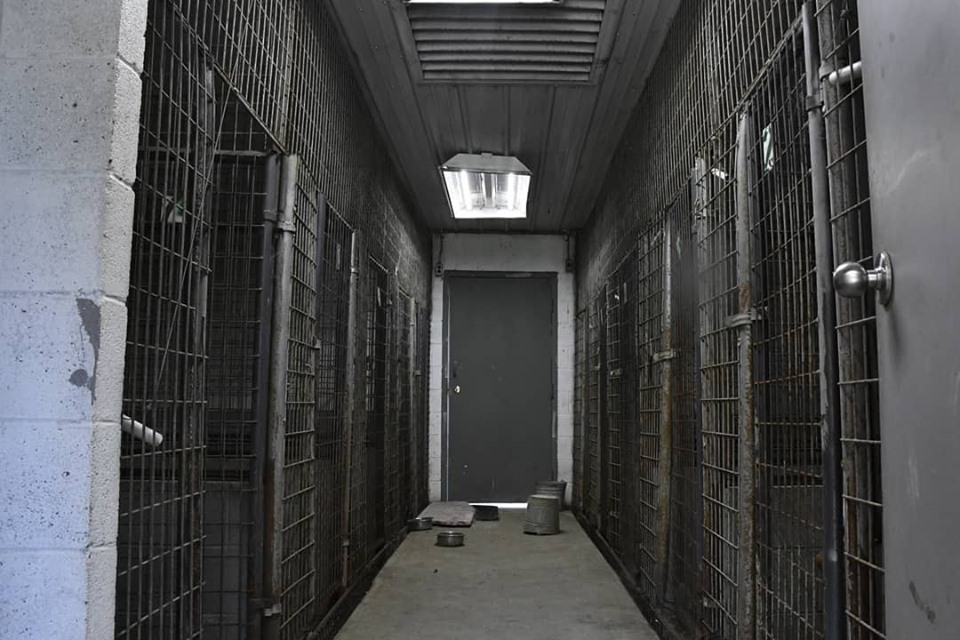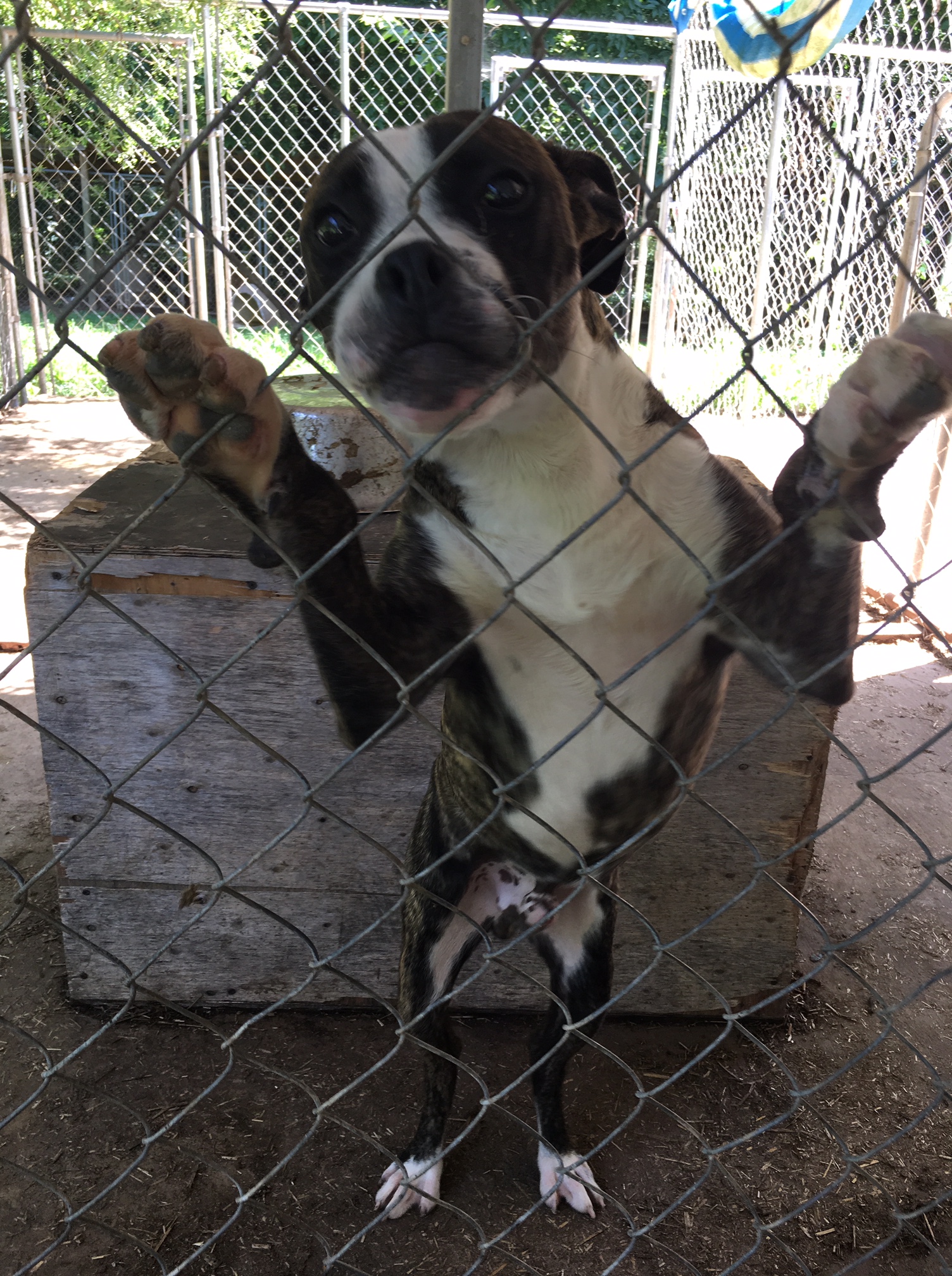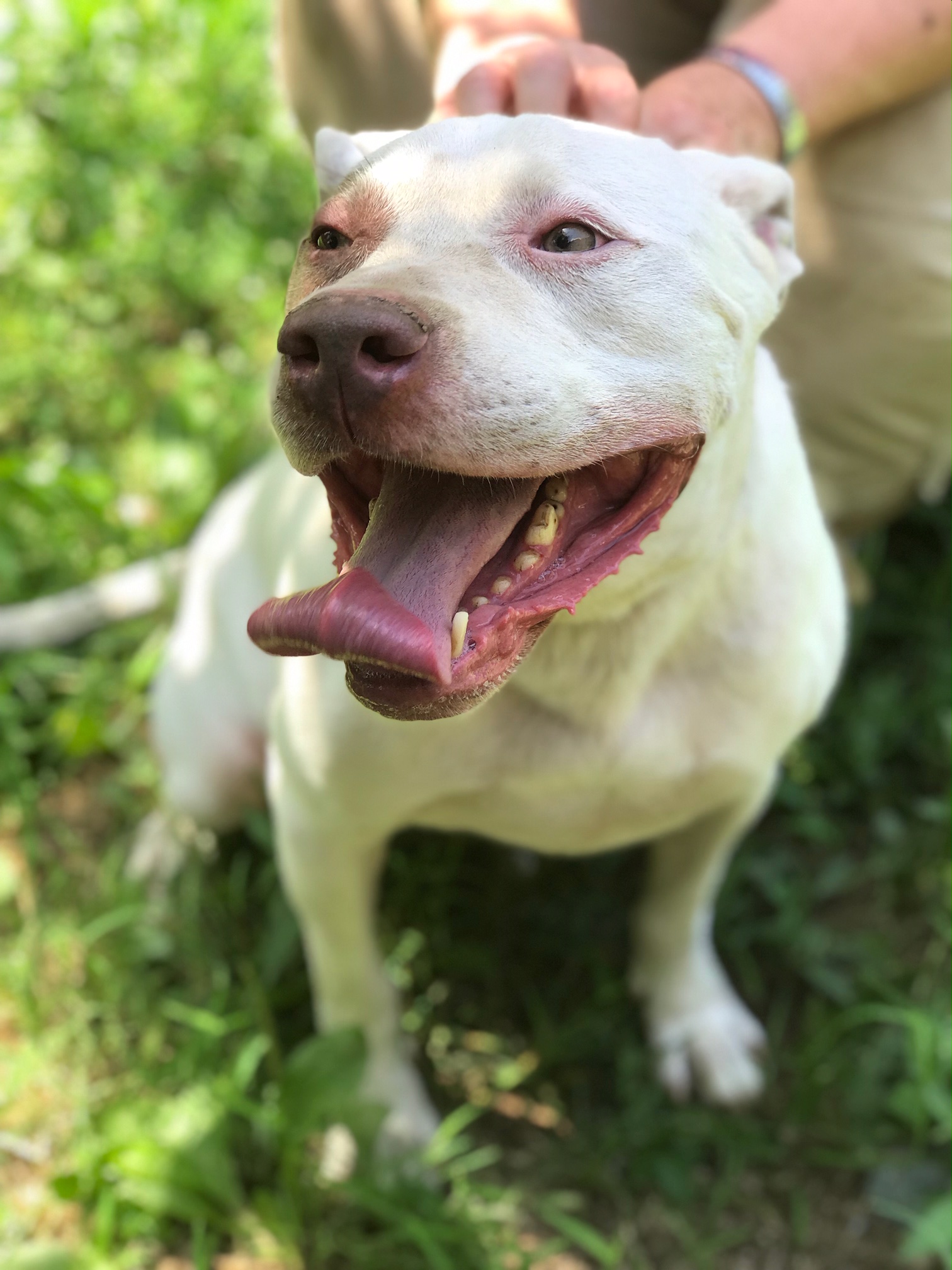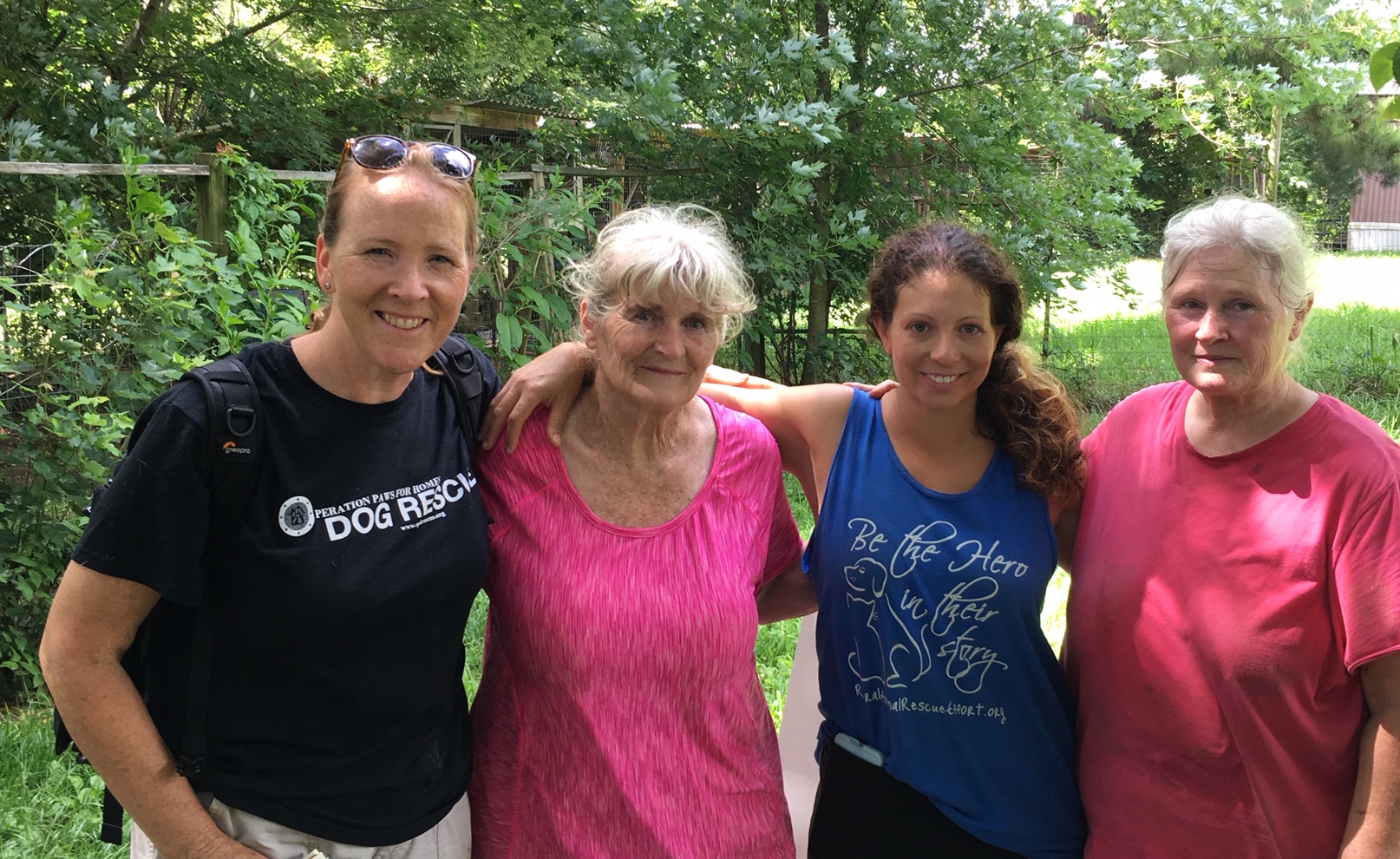After plying Ian with eggs and bagels, we drove out to Trisha’s place, home of her rescue, RARE (Rural Animal Rescue Effort). Disguised as a pretty, petite, energetic normal person, Trisha is a powerhouse who rescues animals all over western Tennessee, fighting for them on every level. She will not tolerate your nonsense and has no qualms with calling a spade, a spade.
“I’m not really a human-person, I’m a dog-person,” she told me. Currently, she fosters thirty-five at her house (along with dozens of cats and kittens, and a few rabbits.
Driving west with Trisha in the back seat, it was hard to keep up with her busy mind as she rattled off the situations we were headed for. Our first stop was the Huntingdon dog pound in Carroll County. She explained that she hoped we’d be able to get in but hadn’t gotten confirmation of that from the dog catchers she’d contacted. Dogcatcher is really what they are called. The county has two dogcatchers who make upwards of a thousand dollars a month. She checked her phone again. No response. “They don’t give a shit,” she said.
This was clear when we arrived. The Huntingdon Animal Shelter is a small cement building surrounded by a tall chainlink fence with three strings of barbed wire on top. It is a desolate spot, one where you could easily set a murder scene for a horror movie.
There was no sign indicating that dogs were kept there, just a warning sign cautioning that you are entering a firing range and will be prosecuted (shot?) for trespassing.
Four dogs were in residence, living in kennels carpeted with poop. The dogs had no choice but to lay in their own urine, but got up and greeted us excitedly. There was a small, brown pitbull who was emaciated and covered with crusted poop. A few kennels down were two dogs together in one kennel with twice the poop. One had a belly likely bloated with worms, the other Trisha was pretty sure was a sibling of a dog back at her house that she had rescued a few weeks before. On the backside kennels there was a sweet, yellow dog with doe-eyes and a nylon collar, also frighteningly thin, who had a soft cough. “He’s heartworm positive,” Trisha said. “I’m sure of it.”Trisha told me that the dogs are just held in this pound until the dogcatchers get tired of taking care of them. Then they load up the dogs and take them to the local clinic to be destroyed (it only costs $25 a dog).
“But what if you say you’re going to take them?” I asked.
She shook her head. “They take them anyway, but one of the techs there will call me. Then I try to go get them.”
I thought of the two and a half hour drive we’d just made to get there, the thirty-five other dogs presently at Trisha’s house. As if reading my mind, she muttered, “I just know they’re gonna kill these guys soon, and I can’t get out here until Sunday. I’ve got to get some dogs adopted.”
These four were new to Trisha, so she got her supplies. I held each dog as best I could (which wasn’t always great) while she gave them a heartworm blood test, dewormed them, gave them heartworm preventatives and applied flea/tick preventatives. They were sweet and tolerant. The little pitbull rolled on her back and sighed contentedly at our touch. I could feel her bones poking me as I held her She didn’t flinch or fight as Trisha stuck her with a needle, squirted dewormer in her mouth and shoved pills down her throat.
We did the same with the other three and sure enough, Trisha was right the blond boy was heartworm positive. Thankfully, though, the others were not.Next Trisha cleaned out four kennels, hosing the dried poop and filth down the open drain run that ran through each kennel.

We moved the dogs to clean kennels and fed them. Ian took lots of pictures. Trisha and I did a quick dog-test with the pittie girl and the blond boy in the hopes that I could share the video with OPH. Both sweet dogs seemed more than adoptable to me. In fact, I really wanted to load up that pittie girl in our car and take her with us, despite her smell.
Trisha wanted to take them all, but with no open kennels at her house, she said she’d have to wait until Sunday. She left a message on the unresponsive phones of both dog catchers telling them that she’d just dewormed and tested the dogs and that she was coming back for them. “Don’t kill them,” she said. And then she left a message at the vet clinic asking them to call her if the dogs were brought over. I asked her if they would really call and she said, “It depends on whether the one vet tech is working.”
We left Huntingdon and headed for another rescue, much like Tabi’s from yesterday. Anne and Kim are a nurse and a teacher, sisters in their sixties who care for seventy dogs at their rescue in Dresden, Red Fern. Like in Huntingdon, Weakley County has no real shelter. There is simply a dog pound where dogs are held and killed. Anne and Kim are not actively taking in dogs, since so very few ever leave. But that doesn’t change the fact that dogs still find their way to them.
Trisha met Anne and Kim while she was living in Buffalo, NY working for a rescue that pulled from Red Fern. She couldn’t believe the things they told her and had to come down to see for herself. Not long after, she moved down here, living in Anne and Kim’s basement until she got on her feet and began rescuing independently.
Anne and Kim were happy to see us, hugging Trisha and introducing us to dog after dog. Kim is a teacher with a warm smile and a soft voice– I am certain there are people all over Weakley County who recall her name when they think of their favorite teacher. Anne is a nurse; she is sharp and thoughtful and told me about hammering in the last nail on Thanksgiving Day when she finished designing and building the kennels. Both women struck me as the kind of people I could talk to all the day long, intelligent and interesting and passionately committed to saving animals.
All of the dogs at Red Fern live outside in large, homemade kennels with roofs. They are shaded by groves of trees and have worn tarps attached to the side to provide more shade and protection. I asked Anne if they had volunteer help and she mentioned one regular volunteer who helps out. Looking around at the sprawling grounds covered with kennels, it was hard to imagine that these older women care for all of it, but they do.
I asked Anne how they got into this business. She told me about Tiger, her beloved dog who died fifteen years ago. When he passed, she decided she wanted to give something back. “It was the first time I ever had that feeling in my life,” she said.
So, she volunteered to foster for another organization and they brought her nine dogs and some cattle panels to keep them in. “The dogs all got out,” she laughed. Nine? And here I was thinking it was such a trial when I cared for my first foster dog, a tiny beagle who ate all the kids’ stuffed animals.
This went on and after a while, Anne and Kim decided they could do this themselves. So they created Red Fern Animal Shelter. Like Tabi and Karin 4 Kritters, they began doing what the county should have been doing, paying for it out of their own pocket and now with their Social Security.
It is clear that Anne and Kim love these dogs. In fact, it’s hard for them to imagine letting them go to just anyone. There are very few adoptions. They depend on Trisha to pull some of their dogs, the ones she thinks she can place. “If we could just find homes for the young ones, the old ones could stay,” Ann told me.
We visited with an adorable, tiger-striped puppy with a beautiful boxer face, letting him out to bound around the yard for a bit. This six-month-old guy came to Red Fern suffering from demodex mange, but was strikingly handsome now.
Then Trisha snapped pictures of Chance, a huge, white 6-year-old pitbull with an equally huge smile. He’s been there too long and is such a love, she’s certain there must be a home for him.

I spent a few moments with Lyric, a young black dog who looks so much like the standard-issue OPH dog. She was thrilled for my attention and happily gobbled up the treats I passed her.
We ran out of time too soon, knowing that we still had the two and a half hour drive back to Laura’s. Trisha needed to get home to begin her four-hour evening feeding/cleaning. We gave Anne and Kim a few donations and promised to spread the word, but wished we could do more.
We’d hoped to stop in to see the three other city pounds nearby – all much like Huntingdon, Trisha assured me, but there wasn’t time.
It is already time to head for home, but I wish I could stay. There are so many stories here. So much happening that seems impossible. I don’t think many people, at least people I know, would believe what is happening down here. I can’t imagine my little town tolerating Animal Control Officers who just kill dogs on a whim (one of the pounds around here Trisha told me just shoots the dogs with guns, doesn’t even bother with the $25 fee to take them to the vet). Why is it that this can happen here? Where is the outrage?
I asked this question of Kim and she said, “People don’t care. It’s just a dog.”
Those were the same words I heard a few months ago in South Carolina. Is there a line somewhere between north and south, like the Mason-Dixon line, where people stop caring about animals? Where animals become property, not pets? Where you only feed them garbage and don’t worry about exercise or enrichment? Where when you get tired of them, you dump them on a local rescue or take them to the pound and leave them to be euthanized?
At the same time, it’s hard to imagine anyone doing the things that Kim and Anne and Trisha and Tabi and Amber do to save dogs. Why is this work left to them? They are soldiers in this battle against apathy and cruelty that should not be. That doesn’t have to be.
But how do you make people care? Why do they look the other way when these dogs are abandoned in a locked, lonely, barbed-wire place all alone to starve to death, only to be eventually be dumped at a vet to be killed or worse yet, shot to death by the hands that should be caring for them?
If I wasn’t here seeing it with my own eyes, running my hands over the bones of these dogs, looking into their desperate eyes, I wouldn’t believe it.
But it’s happening. All over the place. I only spent three days here, saw just a tiny sliver. When I imagine all the other dogs, suffering worse with every mile I travel further into the rural places so many have forgotten, it feels unbearable. I want to do something, do more. These remarkable people I am meeting should not be left alone with this fight.
While I know money cannot fix this problem, it can help the people who are trying to. If you’re moved to give something to Trisha’s work with RARE, you can visit her website or shop from her Amazon Wishlist.
Anne and Kim do not have an Amazon Wishlist, but I encouraged them to create one (as if they have the time to do it!) and I’ll let you know if they do. Meanwhile, you can visit their website or find them on Facebook.
We are headed home, traveling with two dogs who needed a ride north to their foster homes. We’ll make one quick stop at a small county shelter east of Nashville, just for another point of reference. There is still so much to say. The work here is far from done. Awareness is the first step. Someone has got to let these dogs out.
Thanks for reading. Please spread the word.
Cara



Paul Handover
You describe such a contrast between those that care for and love the dogs and those that don’t.
Cara Sue Achterberg
There is and, for the life of me, I can’t figure out why. Even if you don’t ‘love’ dogs, there is no excuse for treating them cruelly and certainly no excuse for killing them senselessly. so much about this situation needs to change. Since I don’t know where to start I will keep writing and telling and exposing it.
Randi Sumner
Thank you and that everyone who does this selfless work. Our 2 year old is the child of a pregnant momma rescue from Tennessee that was brought up to a rescue in the Northeast so that she could be cared for. I wonder if she is the puppy of a Trish rescue
Cara Sue Achterberg
That’s entirely possible. I meant to ask Trisha if she knew the number of dogs she has saved over the years, but it is likely in the hundreds, if not thousands. Laura, too. thank you for choosing to rescue. If half of the people who are looking for a pet went to a rescue or shelter instead of a breeder, we would empty the kennels in just one day.
Martha Kennedy
I sometimes wonder if the awful shelters are awful not because the people who run them are awful or if the people have reached a state of despair over the situation. I look back over the years of my dog ownership (1987 I got my first real dog) and so much has improved. I think the improvement is due more to a change in the mentality of the society around the shelters than anything else. Money helps a lot, but here in the San Luis Valley which is an impoverished and enormous rural farming community, none of the shelters are kill shelters. There are several legit foster-based rescues that work tirelessly raising funds for the dogs. Some rescues here haul their dogs to big cities every weekend to find them homes.
When I popped up on Facebook after seeing Teddy’s photo, and showed interest in Teddy (my new Aussie), the volunteers in the shelter in my town were on it immediately, “Can you foster him? Can you do something? We’ll provide everything for him.” I wasn’t even sure, but it was enough to get me down there to meet him. And now he’s asleep at my feet.
You’re completely right that if everyone looking for a pet went to a shelter for that pet, we’d have this problem licked, so to speak.
At the same time, there are idiots who drive around with their dogs in the back of their pickups with the tailgate down and then express sorrow when their dogs are lost or dead beside the road. I dunno…
Cara Sue Achterberg
There are many places where it is ‘improved’ which is why it’s hard to believe it can be the way it is in Western Tennessee. As if no time has passed, nothing has changed. Truly, I am home now, but still stunned.
Martha Kennedy
I wonder about that part of the country. I wonder about the mentality that thinks that things as they were or have been is OK. I wonder at people who don’t look around and see how it could be better — for dogs and a lot of other things.
Steve Jones
When I worked in an animal shelter in East Tennessee several years ago, I thought things were horrible until I heard about other, more rural shelters (or as most people down there called them, “the pound”) in the state that actually still killed excess animals using a gas chamber. Our executive director told me that, before the humane society took over our shelter in Knoxville, they weren’t even using sodium-pentathol injections; many were just shot. It’s discouraging to learn that that method is still being practiced, although, frankly, I’m not really surprised.
People who naïvely maintain that pet overpopulation is a “myth” just make me want to scream. Sure, there may statistically be fewer dogs available nationwide than there are people who say they want one. But many of those people would not provide real, loving homes. Should we just give dogs (or cats) to anyone who asks, even if they have no intention of spaying/neutering them or welcoming them into their families? How does that solve anything beyond (maybe) improving some metrics? Quality of life also should be a factor, not simply how many dogs we can get out of site and out of mind — SOMEwhere (i.e., to anyone who wants one).
When I worked in the Knoxville Animal Shelter, there often were guys who came in looking for a dog — and they made no attempt to hide this — to be a watchdog and nothing else. These folks saw/see nothing wrong with tying a dog to a tree or a fence all day, so matter how hot or cold it gets, to lay in its own feces as long as it barked when someone drove or walked nearby. Bring an animal into the house? “What?” they’d say. “The cats would scratch the furniture! The dog would bring in fleas and shed!”
I hate to generalize, but to many, many people in the South (and other parts of the work, for that matter), animals are nothing more than chattel . The woman who said, “They don’t give a shit” pretty much summed up the redneck mentality of the problem. Many (if not most) southerners, by my experience (and I’ll be the first to admit I saw the worst of them), truly do not care — to them, they ARE “just” dogs (or cats) — because that’s how they were raised to view them. Frankly, there are many people who simply do not deserve to have animals in their care.
Yes, there are a lot of people who DO care and do what they can — some, like the women profiled in this post, with courageous, Herculean efforts — to try to stem the tide at least a little. But, at least in the South, they are few and far between. (Again, just my experience. I do not have data to back this up, but I’ve seen so much cruelty and bad behavior down there, it can’t help but affect one’s objectivity. Truly, it was not easy being a journalist when I was documenting the situation.)
In my opinion, what we need are mandatory spay/neuter laws and to outlaw purposeful breeding (no matter how “reputable” the breeder supposedly is), but these things aren’t going to happen. One thing we CAN do to make a difference long-term is to educate people, often one person at a time, like Cara and others do, using their skills and talents (in Cara’s case, powerful writing) and spreading the word about the situation — whether people want to hear about it or not. It may take generations. As harsh as this may sound, some people’s attitudes and mindsets will never change — like racists who will never let go of their hate — so we’ll probably have to wait for them to die out. In the meantime, in addition to rescuing and caring for as many animals as we can (e.g., in OPH foster families), we need to focus much of our energy on educating today’s children so that, hopefully, most of them will grow up to have more compassionate and caring attitudes toward animals. Then, hopefully, they will raise THEIR children to be compassionate and see dogs and cats as more than simply disposable accouterments of life.
All we can do is keep talking about it to slowly affect change and then, as more people slowly become aware, there will be more people like Trisha, Ann, Kim and others who do all they can. This includes all the fosters who open their homes to welcome frightened innocent creatures who need a second chance. The people who truly care are the only hope of really changing things. So keep writing, Cara; keep taking pictures of this, Ian. Doing so while working in an animal shelter in the early ’90s changed my life and outlook on all this. It’s hard to look at, I know. But, again, showing and talking about this reality to those who do not know (or don’t want to know) is the only way things will ever really change for the better. Even if we could get mandatory spay/neuter laws and outlaw breeding, people would still violate them. Changing people’s hearts and raising a more compassionate, caring generation is hard, and though I do not foresee the needle moving much in my lifetime, things can — and must — change.
Saving Them One Dog at a Time – Who Will Let the Dogs Out?
[…] was reunited with a dog I met last June at the Huntingdon Pound. Fanny was emaciated and poop-covered and had the saddest eyes you could ever imagine, yet still […]
Home Again with a Stowaway – Another Good Dog™
[…] longer covered with poop and emaciated and waiting to be killed in a pound in western Tennessee. I wrote about the Huntingdon Pound on the Who Will Let the Dogs Out blog, it was by far the saddest situation I’ve seen in my […]